Intro to Sociology part 2
1/115
There's no tags or description
Looks like no tags are added yet.
Name | Mastery | Learn | Test | Matching | Spaced |
|---|
No study sessions yet.
116 Terms
What is secularization?
Removal of religion from other elements of life, becomes less engrained in institution, becomes more of a positive thing
Decreasing religiosity
coping/survival not dependent on religion anymore
fewer existential insecurities
rationalized societies
more social security
What is religious stickiness?
Strong homogeneity of religiosity in geographical areas
Within regions, religious patterns remain stable over time
How to understand this stickiness —> transmission of religion: people conform to those in their surroundings; conformity
What is the Cohort effect?
Societal changes that are due to generational replacement
Voas and Chase (2016) state that it is debated whether or not the US is a counterexample of the ‘secularization’ thesis.’ Based on the article, give arguments why the US is often considered a counterexample
Religion in the US influences politics, education, human rights. US has religious freedom, strong expression of faith, and many denominations in the US competing for believers
—> US is modern, but religious
What is stratification?
unequal distribution of valuable goods
health
well-being
living standard
Underlying causes
income
wealth: assets minus debts
What is ascription?
Is characteristics set at birth, such as family origin and ethnic origin
What is intergenerational mobility?
is the changing position between parents and their children in the stratification system
What is the modernization-mobility theory?
Argues that one’s opportunities in getting ahead in the labor market depend on family origin, and the level of modernization in the country
What is the cultural reproduction theory?
States that counterforces emerge as a response to modernization processes
Status maintenance leads high-status people to invest in the origin-education link —> creation of cultural capital —> transmitted to the children, who then achieve more education
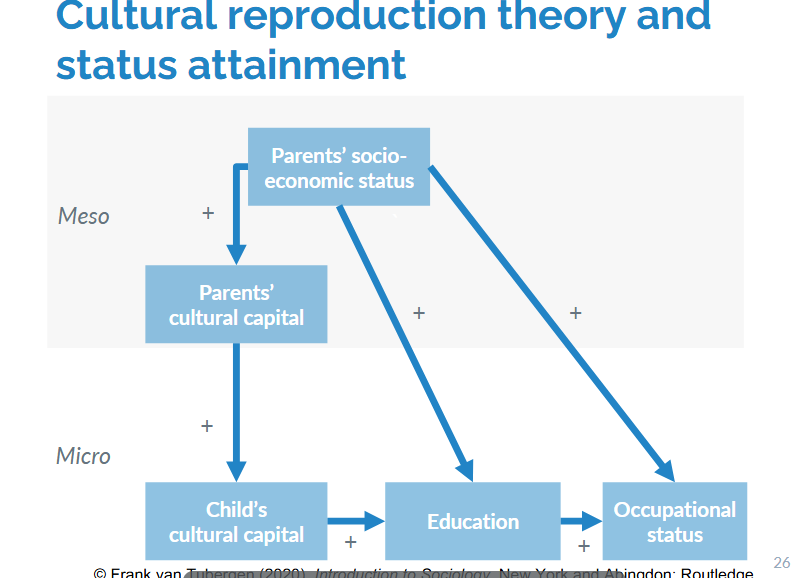
What two concepts did Newlands and Lutz discuss?
Occupational social status: subjective ranking of individuals or groups in terms of honor, esteem, and respect
Occupational prestige (Treiman): subjective ranking of occupations in terms of prestige and respect
correlated but distinct!
What are the two bases of social stratification?
Social class and social status
What is the Great Gatsby Curve?
The strong association between income stratification and (lack of) inter generational mobility
In contemporary societies, higher within-country income stratification is associated with lower intergenerational mobility in that country
Why? In stratified societies, like the US, private schooling more prevalent while publicly financed education is more scarce
—> only the rich can afford private education, making education more dependent on income —> reduction in intergenerational mobility
What is the Preston Curve?
The strong positive association between economic development and life expectancy
What are “valuable goods”?
“something” that people value, such as things for their well-being, things for living standards (food, house, decent toilet), things for their health (access to healthcare)
What is the difference between between-country stratification and within-country stratification?
between-country: unequal distribution of valuable goods between countries
within-country: same thing, but just within a country
What is the definition of a “social class”?
group of people who hold similar occupational positions
key base of social stratification
What is the Erikson-Goldthorpe-Portocarero (EGP) class scheme?
Differentiates seven social classes: service class, routine non-manual, petty bourgeoisie, farmers, skilled workers, non-skilled workers, and agricultural laborers
Various criteria:
the skills required for the occupation
the sector of employment
the divide between manual and non-manual work
—> means people with different occupations can be grouped together in the same social class
What is the Treiman constant?
Occupational prestige rankings are highly similar over time, across countries and have strong agreement between raters
What is the Gini-coefficient?
Summarizes the overall stratification within a society?
Range: 0-100
0 = everyone in a country has the same income or wealth
100 = all the income or wealth is in the hands of one single person
i.e. higher the Gini-coefficient, the higher the stratification
What is intergenerational elasticity (IGE)?
Measures the extent to which the relative position of parents in income distribution is a determinant for the relation position of their child in income distribution.
i.e. The higher the IGE is, the lower the intergenerational mobility in income.
If IGE is 0, the income of children is fully independent from that of their parents
If IGE is 1, the relative income position of the children is exactly equal to that of their parents
If the American Dream is true, should the IGE be low or high in the US?
It should be low, as lower IGE means the income of the children is quite independent from that of their parents
What was being investigated in the DiMaggio study (1982) (introduced in class)?
Investigating the effect of cultural capital on high school grades
Independent variables: cultural capital + family background
dependent variables: high school grades
What is the OED model?
O: Origin (meso level)
E: Education (micro level)
D: Destinations (in this case, Occupational status)
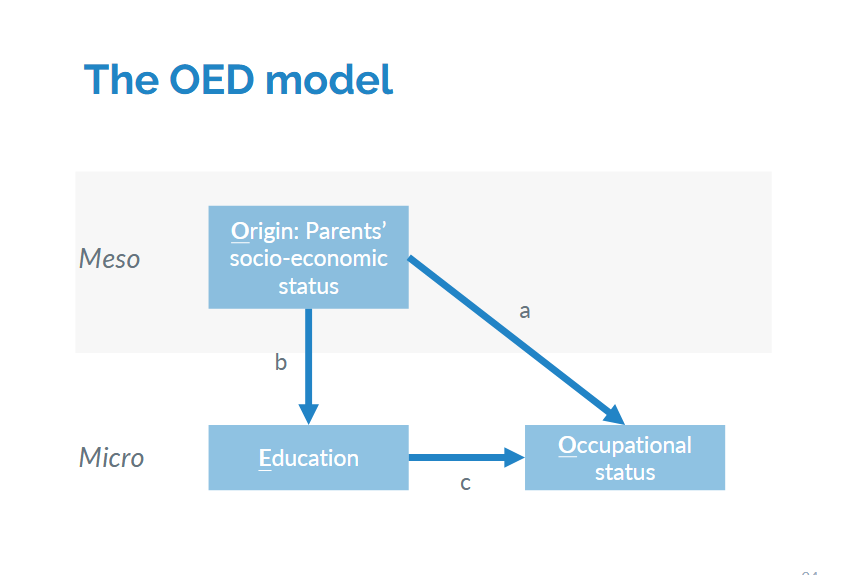
What is cultural capital?
refers to resources that come from:
(1) the affinity with higher status values, beliefs, norms, and corresponding practices (ex. high status cultural activities like visiting museums) and
(2) language competencies
Proposition: The higher people’s socio-economic status, the more cultural capital they will have
What is the difference between Intergenerational and intragenerational mobility?
Intergenerational mobility: changing position between parents and their children in the stratification system
Intragenerational mobility: changing position in the stratification system over the life course
What is the “one percent” concept?
The within-country stratification in income and wealth in contemporary societies is highly skewed and much of the wealth is in the hands of the top 1 percent
What is a mobility table?
Table which cross-classifies origins and destination position in the stratification system.
Origins: social position of the parents i.e. social class
Destinations: social position of the child(ren)
Common way to assess how much intergenerational mobility exists in society.
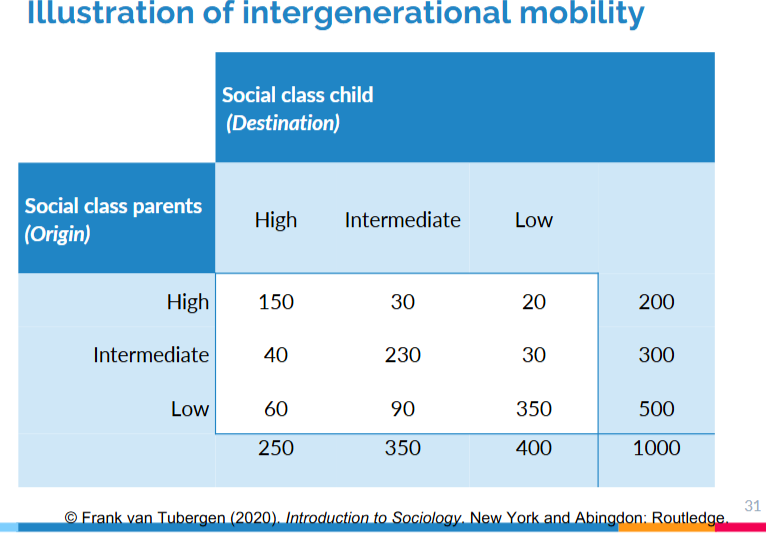
What is absolute mobility?
The total number of position changes
You can find this kind of mobility by considering the numbers in the off-diagonal cells.
ex. children who are upwardly mobile (destination is higher than origin) + those are downwardly mobile = amount of children having a social class position different from the parents
ex. upward mobile children (in this chart): 40+60+90 divided by 1000 and then times 100 for the percent = 19% of the children
downward mobile children (in this chart): 30+20+30/1000 × 100 = 8%
Together, this makes 27% of the children having a social class position different from that of the parent(s)
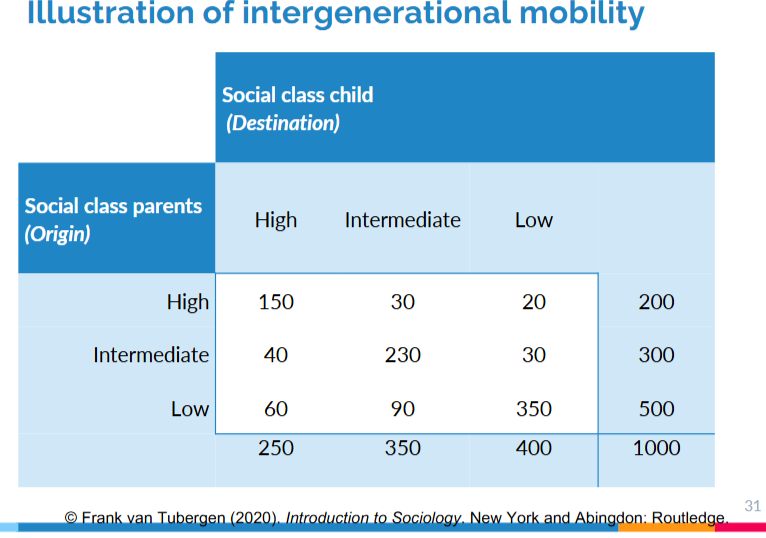
What is relative mobility?
Indicates the degree of inequality between children who come from various backgrounds (origins) in their opportunity to access social positions (destinations)
Indicative for the true openness in society (i.e. social fluidity)
What is structural mobility?
mobility that is due to changes in the volumes (margins) of available social positions
ex. 500 parents are lower social class, whereas 400 children are lower social class
consequence: 100 children from low socal class background have a different social class because of these structural changes
Another way to think of it: among the 500 children who come from a lower-class background, only 400 can occupy the same position as their parents: the remaining 100 are “pushed into” another class because of changing labor market structure
What is the status-attainment process?
Process by which people acquire a certain position, such as an occupation
Illustrated in this OED model
Education of the child (E) to the relationship between the socio-economic status of the parents—origin (O)—and the occupational status of the child —destination (D)
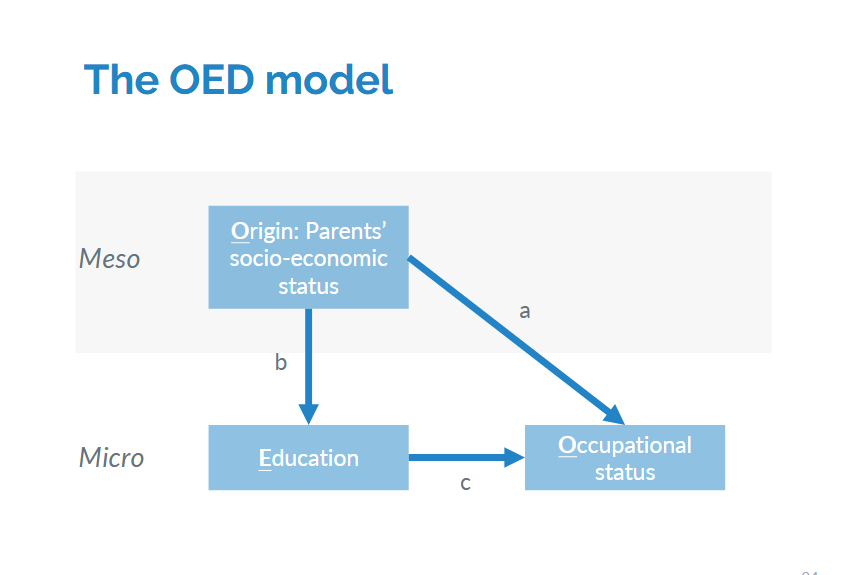
What did the Blau-Duncan study investigate?
the idea that social mobility can be placed under the general question of the role of ascription (ascribed characteristics) and achievement (effort, performance)
What terms from the book did the Stratification & mobility paper by Herman G. van de Werfhorst explore?
Name of article: ‘Is Meritocracy Not So Bad After All? Educational Expansion and Intergeneration Mobility in 40 countries’
Focused on between-country stratification more than within-country
Social class (occupation, education)
Intergenerational mobility (social origin parent, destination of child)
Relative mobility (changes in opportunity)
What is the Contextual dependency theory?
More education access —> family background matters less
Shift from ascription to achievement
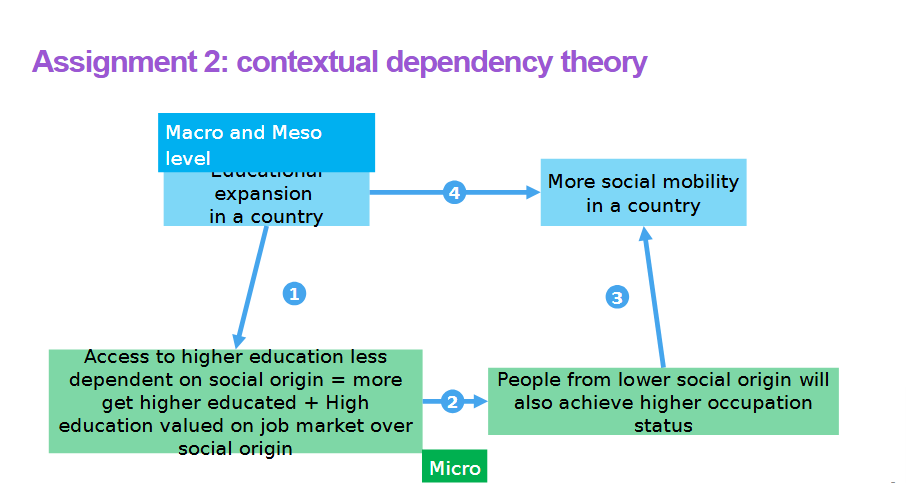
In the period between 1980 and 2015, within-country stratification has (increased/decreased) and between-country stratification has (increased/decreased)
within country has increased, between country has decreased
Mobility can be due to the changes in the margins of available social positions. What type of mobility is meant by this?
structural mobility
According to the cultural reproduction theory, cultural capital can act as a compensatory mechanism. What is meant by this?
high-status parents want to maintain their status by investing in the education of their children in times of modernization
What forces counteract the modernization-mobility theory?
Cultural reproduction theory —> high status parents compensate by transmitting culture
Financial resources —> high status parents compensate by using their financial resources
What is the myth of meritocracy? (relates to Werhorst article)
The false narrative that everyone has an equal chance at social mobility if they just work hard enough
i.e. not everyone has the same ladder to climb
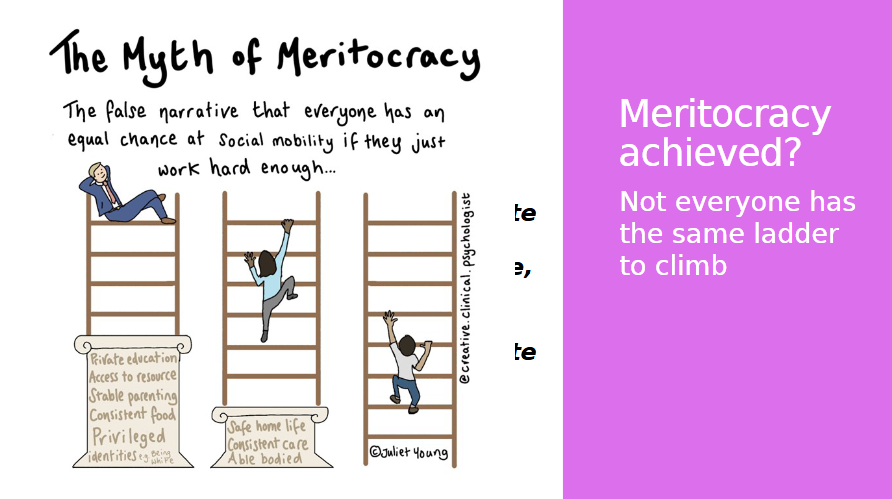
What is Werfhorst’s Direct persistence theory?
Elite families compensate for broader education access
Use of social connections, cultural capital, and financial resources
(macro/meso) Educational expansion in a country
—> (micro) high social origin will invest more in education/capital to compensate + high social origin still highly valued on job market
—> (micro) people from higher social origin will still achieve higher occupation
—> (macro/meso) low or stable social mobility in a country
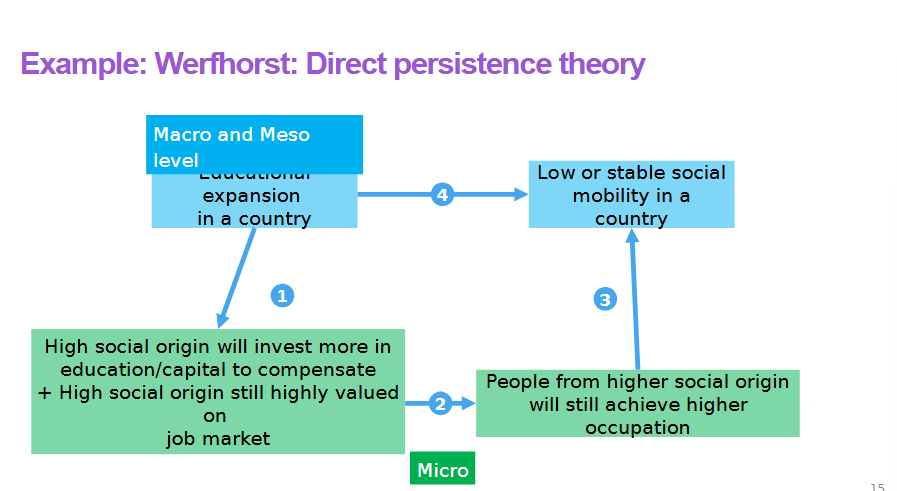
What is human capital (or human resources)?
refers to people’s knowledge and skills insofar as these are relevant to the labor market
What is the human capital theory?
developed by economist Becker;
argued that precisely because education is a “Resource” or “capital” and it is such an important determinant for getting a (good) job in the labor market, people deliberately make investments in their educational resources
What was Granovetter’s theory of social capital?
Strong and weak ties and how people generally find jobs through informal contexts (personal ties) rather than via strong ties or formal ties
Weaker ties have more useful, less redundant job information than strong ties
What was Burt’s theory on social capital?
Structural holes (between two communities)
G and I have a brokerage position which gives control and informational advantages
controls how much information flows between the two
also a weak tie between G and I
What is labor market discrimination?
employer’s unequal treatment of individuals with the same human capital, based on their group
What are the two mechanisms of discrimination? What is a difference between the two?
Taste-based discrimination: employers prefer in-group members above out-group members; prejudice
Statistical discrimination: employers are poorly informed about the candidates knowledge and skills, and therefore use group characteristics
ex. making a judgement based off someone’s accent; activated stereotypes
Difference: statistical discrimination will theoretically disappear over time; “poorly informed’’
What is cumulative discrimination?
Discrimination that occurs in multiple transitions in the life course
What is inequality of opportunity?
The relationship between social background and access to resources
What is inequality of outcomes?
The relationship between social background and labor market outcomes
What is inequality of returns?
The relationship between resources and labor market outcomes
What is the Motherhood penalty?
Finding that mothers have less favorable positions in the labor market than non-mothers
What is “position generator”?
Measure of social resources which captures the occupational positions of respondent’s connections
ex. those who personally know more people with (high-status) occupations have more social resources
What are social resources?
Valuable labor-market-related resources that are embedded in personal networks
What is a structural hole?
Social network characteristic which refers to the lack of social ties between communities
What are social capital theories?
consider the influence of social contexts, on “who you know”
Institutions, settings —> social network resources —> labour market outcome
What is Lin’s theory of social capital?
Network resources from our personal ties
Information on vacancies, well-fitting positions
“Putting in a good word” —> recommendations from personal ties
Help with interview and application —> increases in human capital
What is the article for the Religion unit? What were its main findings?
Is the United States a counter example of the secularization thesis? by David Boas and Mark Chaves
Religion in the US influences politics, education, human rights. US has religious freedom, strong expression of faith, and many denominations in the US competing for believers
—> US is modern, but religious
Why they argue it’s not a counter example; still the same underlying secularization process as there has been a decline in religiosity for decades, and a generational shit
They observe cohort differences.
Main findings: American religiosity has been declining across generations, similar to other Western countries, just at a slower pace than Europe
Why do men have better labor market positions than women in contemporary societies?
Men generally have more human capital, social capital, in-group benefits (inequality of opportunity), which leads to inequality of returns as they then have a better Labor market position
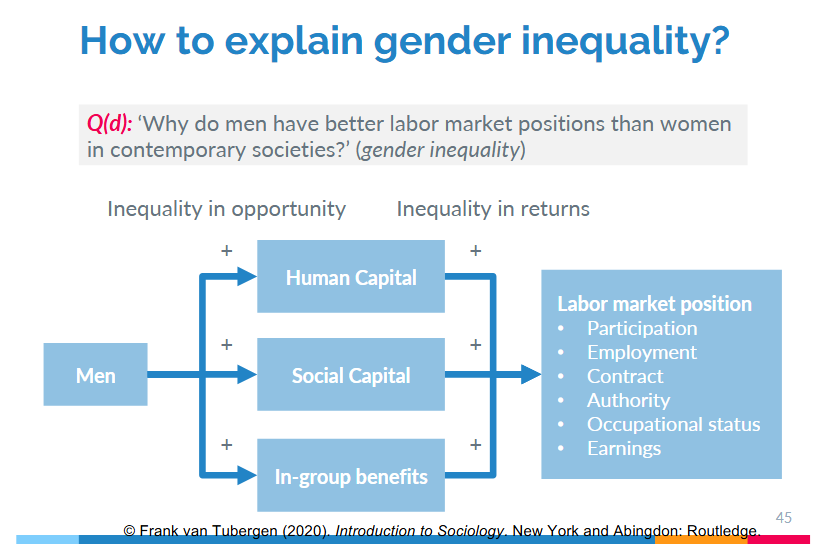
How does the social control theory explain gender inequality?
argues that two mechanisms generate gender inequality
deviations from norms results in social sanctions
social norms become internalized
translation into gendered aspirations (ex. men:breadwinner, women: household activities)
What is gender hypersegregation? What is a possible explanation for it?
Men and women work in very different occupations in contemporary societies
Possible explanation: economic development link
In more economically developed countries, individual fulfilment and self-expresssion are more important cultural values
AND many people hold gender essentialist beliefs i.e. the idea that some traits are distinctively male or female
—> could explain the differences in the gender gap
What can internalized gender norms lead to?
Can lead to altered ambitions, hypersegregation, discrimination (esp. statistical), lower human capital (esp. STEM), differential social capital
Suppose that employers systematically discriminate job candidates who have tattoos. This is
because, after having been exposed to media messages and stories about criminal gangs in which
people with tattoos played a prominent role, employers acquired the belief that people with tattoos
are less likely to work hard at their job, and more often involved in criminal activities. Which type of
discrimination is this?
This is a case of statistical discrimination, since it is based on the beliefs employers have about one group that a person is a ‘member’ of. Beliefs about group averages (in productivity, skills, talents, crime) are used to make inferences about the quality of an individual who belongs to that group
Family structure is part of people’s social background. Explain how differences in the labour market may emerge between on the one hand children of divorced parents, and on the other hand children whose parents are together. Use the concepts ‘inequality of opportunity’ and ‘inequality of returns’ in answering this question.
A. Divorced parents often see a reduction of financial resources (Inequality of opportunity). Having fewer financial resources limits the career of their children (returns).
B. Having divorced parents may lead to stress and emotional problems-which can be seen as reduced human capital (opportunity). Having stress, emotional problems will then reduce labour market outcomes (returns)
Why does Burt argue that people with a brokerage position in the social network of an organization have more favorable job outcomes?
Because this position gives informational and control advantages
What is true about using correspondence-testing to detect discrimination?
it can detect discrimination only at the first stage (job application)
it can detect at first stage and second stage (job entry)
it uses actors
it can detect discrimination only at the first stage (job application)
What is the social control theory?
people’s social environment influences their preferences and behaviors via social sanctions from those around them
Why is migration a social problem?
Relates to issues in origin countries & destination countries
origin countries: conflicts, brain drain, environmental crises
destination countries: integration struggles, aging society, skilled worker shortage
What is meant by foreign-born population?
First generation: people born abroad
What do social scientists consider second generation?
indicate persons who were born in the host country, but who have at least one foreign born parent
What is the ethnic diversity index (ED)? How does it work?
measures the diversity of ethnicity groups in society as one minus its degree of ethnic concentration, whereby the amount of concentration is captured by taking the sum of the squared proportions of each ethnic group in society
ex. Country G: 95% of population affiliated with one group, and other 5% to the other group
1 - 0.95² - 0.05² = 0.1
Also is the probability that two randomly selected individuals from country G belong to a different ethnic group is 0.1
How to measure who is migrant or ethnic minority? (Two ways)
Objective: country of birth (own/parents)
First gen (foreign born)
Second gen (at least 1 parent foreign born)
Subjective: ancestry
subjective identification with certain ethnic origins
What are the three dimensions of integration?
Cultural: degree of cultural similarity
social: intergroup cohesion
economic: similarity in realizing valued goaks
What is the integration versus assimilation proposition?
I: With increasing length of stay of an ethnic minority group in a certain country, this ethnic minority group becomes more integrated
A: With increasing length of stay of an ethnic minority group in a certain country, this ethnic minority group becomes fully assimilated/indistinguishable from majority group.
Multi-sided: … while the majority also adapts; or: the former minority becomes part of the (new) majority (melting pot/multiculturalism)
multisided is stance most sociologists take
What is the difference between selective integration and spill-over effects?
Selective integration: independent trajectories for cultural, social, and economic integration
Spill-over effects: Cultural, social, and economic integration: interdependent trajectories
ex. acquiring the host country’s language (cultural integration) leads to more interethnic ties (social integration)
What is the baseline trend for the integration process?
Tendency for increasing integration as time goes on
Deviations from this typical pattern
Group differences; ex. mexicans in the US v.s. the Chinese when it comes to learning L2 (second language)
Receiving context
Interplay between group and receiving context
What is a Culture of honor?
Culture which strongly endorses/values reputation and the right to self defense in case one’s honor is threatened
What is the dissimilarity index?
Proportion of group members that would have to move to other geographical area to achieve an even distribution
0 (perfect integration) to 1 (perfect segregation)
What is the Schelling Model?
Under which conditions does the collective outcome of Black hypersegregation emerge?
He argued that even when both groups have only mild in-group favoritism to live in areas with at least some people from their own group, the consequence could be hypersegregation
He argued that this collective outcome can happen because of the interplay between individuals and their context (social interdependencies)
Agent based model
"The parable of the polygons” -adaptation of the Schelling segregation model
Uses 64 square chess board to illustrate this
Assuming mild-in group preferences, Schelling stated that individuals will remain if more than one third of their neighbors are from the same race—> leads to high segregation
Consider the three largest immigrant groups to the United Kingdom in 2017 on the Migration Data poll.
874,000 Polish, 836,000 Indian and 529,000 Pakistani immigrants.
a. Which immigrant group(s) would you expect to socially integrate the most easily, based on group size?
According to Blau’s structural opportunity theory (Chapter 8), group size constraints chances of meeting out-group members. Based on group size, therefore, Pakistani immigrants would be expected to integrate most easily socially.
They are the smallest group in terms of size, leading to a higher likelihood of developing group-bridging ties compared to group-bonding ties
Which processes are at play in the decision for squares and triangles to move? How do these processes take shape in the games?
Structural opportunities and preferences are the core factors that decide whether people move or not.
Structural opportunities take form in the number of similar and dissimilar neighbors directly surrounding a shape. Preferences take form in the minimum percentage the actors want to have in terms of neighbors that are similar to them: “I wanna move if less than 1/3 of my neighbors are like me.”
What is wealth and health progress?
Throughout history, there has been changes to wealth and health. Ex. decline in poverty, rising standards of living and increasing life expectancy
What is peace and safety progress?
From the 15th century onwards, human societies have become more peaceful and more safe
What is socio-economic progress?
Progress in wealth, health, peace, and safety
What is rationalization?
Over time, culture have become more and more rational, i.e. an increase in the rationality of opinions and corresponding products and practices
Weber
Technological progress
Accumulation of technological knowledge and innovations
Scientization
Growth of science and increasingly skilled and educated populations
McDonaldization
Increasing rationality across social domains in society: economy, organizations, politics, sports, art and so forth
What is modernization?
co-occuring and interrelated process of rationalization and socio-economic progress
What is the existential insecurity theory?
The more strongly people are confronted with existential uncertainties, the more strongly they prioritize collectivistic values instead of individualistic values
What is the demographic transition?
the transition within a population from high fertility and high mortality to low fertility and low mortality
What is the second demographic transition?
the change within a population towards extremely low fertility levels
What is the Optimism Gap?
Situation in which people are more positive about their personal lives than they are about society
Rights revolution
Increase of human rights in the second half of the 20th century.
Flynn effect
Gradual increase in skills and abilities of populations in developed countries between 1930 and 1995.
Availability heuristic
]Cognitive bias that people’s judgment of the probability of events, or the frequency of a kind of thing, depends on the ease with which people can think of certain information.
The Social learning theory can help explain the rationalization process. What bias is included in this?
Adaptation bias: states that the more certain opinons are adapted to the social environment, the more likely it is that people will conform to those opinons
when certain ideas and beliefs are based on good grounds i.e. they are more rational, they can be seen as more adaptive
What is horizontal diffusion?
knowledge transmitted within generations
what are indicators of the rationalization?
Technological progress, scientization, and McDonaldization
What is the modernization and individualism proposition state?
States that modernization has contributed to changing values i.e. from collectivism to individualism
What were the results of the school segregation study (immigration & integration)?
RQ: How does parental school choice contribute to ethnic segregation in German elementary schools?
German families are more likely to explore their options. German families are more likely to attend denominational schools, or schools outside their area, while Turkish families are lower concentration in those areas. This can be a tool for preserving inequality rather than promoting equality.